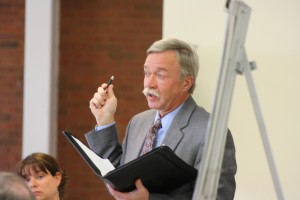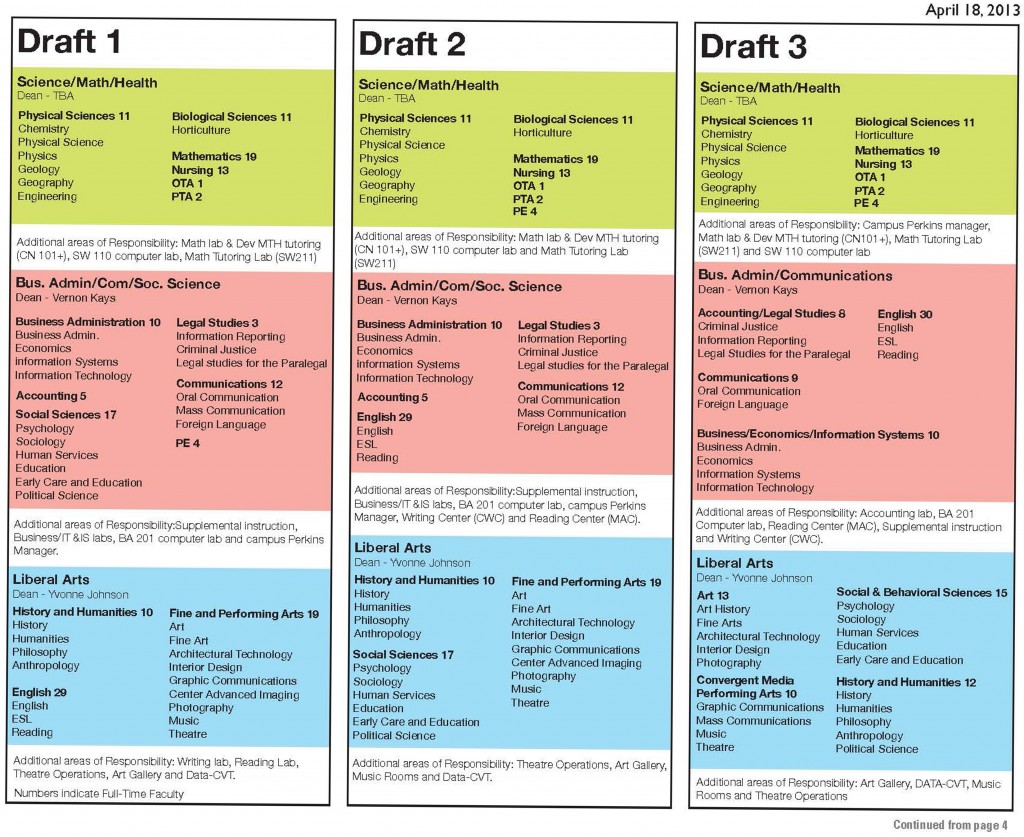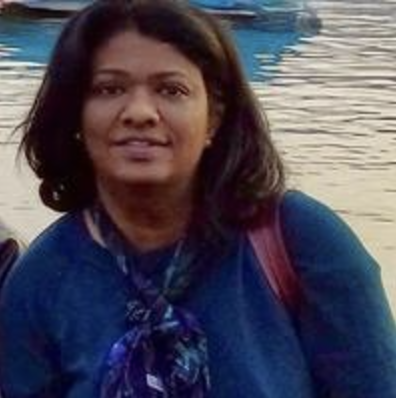President hosts open forum for faculty and staff suggestions

By: Kavahn Mansouri
-Editor in Chief-
On April 1 STLCC-Meramec President George Wasson hosted an open forum soliciting feedback and suggestions from faculty on the possibility of a divisional reorganization. The reorganization aims to eliminate one dean position stemming from the retirement of Business Administration and PE dean Donna Sneed and the imminent vacancy of the Science and Technology dean position.
The forum was set up in a workshop style, seating faculty members at tables to discuss the pros and cons of two drafts handed out at the beginning of the meeting. Each draft [illustrated on page 5] shows the two possibilities for reorganization under three deans instead of four. A third draft was forwarded to faculty and staff April 15 as well.
The Campus Leadership team saw an opportunity to reorganize with the upcoming vacancies, Wasson said.
“This is something we talked about in the campus leadership team, we’re looking at it and saying this is an opportunity we have because half of our dean positions will be open,” Wasson said. “This is something that I took to the chancellor; the chancellor didn’t bring it to me.”
Draft I shows current Humanities and Social Sciences Dean Yvonne Johnson, Ph.D. heading Fine and Performing Arts, History and Humanities and English. Current dean of Communications and Mathematics Vernon Kays Ed.D. will head Business Administration, Accounting, Legal Studies, Communications, Social Sciences and PE. A third currently unfilled dean position will head Biological Sciences, Physical Sciences, Mathematics, Nursing, OTA and PTA.
Draft II displays Kays leading Business Administration, Accounting, Legal Studies, Communications and English. Johnson will hold Fine and Performing arts, History and Humanities and Social Science. The third dean will lead Biological Sciences, Physical Sciences, Nursing, OTA, PTA and PE.
Draft III shows Kays with Accounting, Legal Studies, Business, Economics, Information Systems, Communications and English. Johnson would take on Art, Convergent Media, Performing Arts, History and Humanities and Social and Behavioral Science. The third dean will host Biological Sciences, Mathematics, Nursing, OTA, Physical Education, Physical Sciences and Physical Therapy.
Wasson said the reorganization is stemming for a clerical issue.
“What we’re looking at is reorganizing this down to three divisions so that we would be bringing it down to one dean, not two,” Wasson said. “So we would be downsizing somewhat.”
Wasson said the drafts distributed at the forum were not “written in stone.”
“We need to have some realignment. We need to address where the students are. Where are the credit hours? Where are the demands?” Wasson said. “This is very important to us; I look forward to seeing what we get.”
Wasson said a major part of the reorganization is shifting workloads around appropriately.
“At this point in time, until we have issues that come from our overall budgets we would be reallocating the release time of the remaining divisions and departments,” Wasson said. “We’ll be moving the work around.”
At the forum, faculty and staff members were given a chance to share their table’s suggestions and possible changes to the drafts after a brainstorming session. Several of the tables backed Draft II as the best option for reorganization.
Enrollment Management coordinator Kim Fitzgerald suggested accounting adjunct faculty in the revision of the drafts.
“We would like to suggest that we not make decisions based on numbers. In terms of full-time faculty [the draft] does not take into account the number of adjuncts,” Fitzgerald said.
Department Chair Tim Linder expressed his concern with workload issues.
“It makes me nervous; the increase of workload, not just full-time faculty, but all the different facets that have to do with events, the gallery, music and special speakers, everything that has to do with the different intricacies of the different programs,” Linder said.
Linder added his concern for cross-divisional workloads for faculty members.
“Another problem would be things like a faculty member having workload across a couple of divisions,” Linder said.
Vice President of Academic Affairs Andrew Langrehr said the sheets of ideas and feedback from each table would be collected and reviewed.
“Some tables have sheets and sheets of great ideas,” Langrehr said. “Know that all of these sheets will be taken back and looked over.”
Making sure the divisions equitable is important in the process, Wasson said.
“There is a managerial component here because it doesn’t have to be equal or be exactly the same, but we have to be somewhat fair,” Wasson said. “It has to be equitable but not equal.”
Wasson said feedback from the faculty will be important in the revisions and decisions made regarding the drafts.
The reorganization is aimed to resolve clerical issues, Wasson said.
“There are some cost saving as far as a having one less dean instead of having four. Some may remember when we had seven [deans,]” Wasson said. “This isn’t our first reorganization. We’ve done things differently but there’s not a lot of cost saving. There will be a little bit in the clerical side.”
Wasson said time is not a driving factor in the decision and that the Campus Leadership team is working on its own time.
“There’s no time we have to decide by. It’s our decision as for when we want to go out for a dean,” Wasson said. “Our time constraints are our own.”
Wasson said the campus leadership team would be discussing the results of the forum in the near future.
“We’ll look at these different moves people suggested about different departments,” Wasson said.
Wasson said in a time of change the leadership team is aiming to stabilize the divisions.
“We’re looking at how we’re doing,” Wasson said. “We are looking at trying to stabilize. With all of the changes that are going on we need to have something stable set in place.”
[Speakers from tables represent entire tables views and not solely their own]










